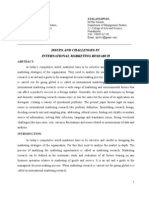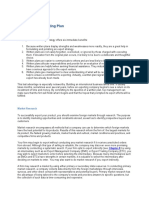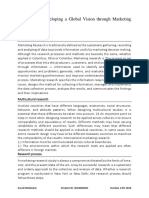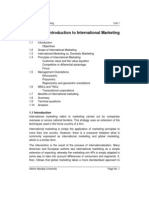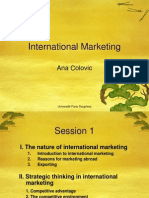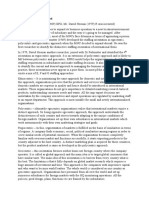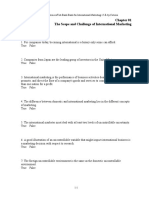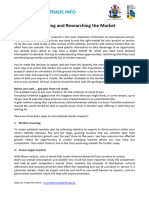IMR
IMR
Uploaded by
Rishi DograCopyright:
Available Formats
IMR
IMR
Uploaded by
Rishi DograCopyright
Available Formats
Share this document
Did you find this document useful?
Is this content inappropriate?
Copyright:
Available Formats
IMR
IMR
Uploaded by
Rishi DograCopyright:
Available Formats
UNIT 14 INTERNATIONAL MARKETING RESEARCH
Objectives After going through this unit you should he able to explain the global marketing research scenario explain the scope of international marketing research describe the procedure for undertaking international marketing research describe the techniques available for international marketing research plan a field research describe the techniques available for interview identify and explain the various steps in analysis of field data and preparation of research report
International Marketing Research
Structure 14.1 14.2 14.3 14.4 14.5 14.6 14.7 14.8 14.9 14.10 14.11 14.12 Introduction Marketing Research : The Global Scene The Scope of International Marketing Research International Marketing Research Procedure Techniques of International Marketing Research Survey Research Techniques of Interviewing Analysis of Field Data Preparation of Research Report Summary Self-assessment Questions Further Rea dings
14.1 INTRODUCTION
In international marketing, the marketer is faced with a dilemma of having too much data and too little information. There is plenty of global data from sources like the World Bank and other international bodies, but often a lack of specific information on countries and markets. In helping to reduce uncertainty around decision-making, precise information is the key. Whilst searching for opportunities globally, uncertainties arise due to four main factors: lack of knowledge of the existence of possible new market alternatives, the conditions internal and external to the firm which will determine the consequences of a new alternative, what consequences these conditions when known may have for the firm, and how these consequences maybe expressed in relevant terms of goal fulfillment. This is due to the time lapse between the decision and the outcome of the action decided on. Uncertainty also increases with the degree of "foreignness" of the place of outcome, the cost of information and the learning effect.
13
International Marketing Planning
When marketing domestically, the system is fairly easy to learn. When crossing global boundaries the whole process is exaggerated by necessary paperwork, exchange rates, cash flows and transportation problems to name a few. This uncertainty gives rise to the need for information. DEFINITION Marketing research can be defined as the systematic study and evaluation of all factors bearing on any business operation relative to marketing of goods and service. Logically, marketing research begins before production starts-in fact, even before the factory is built or the plant is set up,' and continues as long as the business remains in operation. Although marketing research is invaluable in the solution of business and marketing problems, it is by no means a substitute for sound business judgement based on knowledge, experience or even intuition. It is an aid and a guide to the managerial decision-making process. It eliminates or reduces guess work by providing facts and throwing light on the areas of enquiry. Objectivity is at the heart of marketing research. There is no difference between the fundamentals of international and domestic marketing research. The research process is basically the same wherever it is applied. Generally, the tools and techniques in foreign and domestic marketing research remain more or less the same but the areas of its application are divergent, creating a variety of operational problems. The environmental factors, for example, that are relevant for marketing may vary from country to country or specific information needed in one country may not be required in another. Within a foreign environment, the changing emphasis on the kinds of information needed, the research tools and techniques required to collect the information and the difficulty in implementing the research process constitute the real problems in international marketing research.
14.2 MARKETING RESEARCH : THE GLOBAL SCENE
As per the study conducted by ESOMAR, the total worldwide market for market research for the year 2001 was U.S. $ 15.9 billion. Exhibit 14.1 given below shows that this market is\ dominated by EU nations and U.S.A., accounting for more than three fourth of the world market. Exhibit 14.1 World Market Research Turnover, 2001 Turnover 2001 % Distribution U.S. $ million WORLD TOTAL EUROPE EU 15 NORTH AMERICA USA CENTRAL/S.AMERICA ASIA PACIFIC JAPAN MIDDLE EAST AND AFRICA 15,890 6,316 5,842 6,577 6,159 775 2,027 1,070 195 100 40 37 41 39 5 13 7 1
(Source : ESOMAR Annual study of Market Research Industry 2001) Based on the above study, it has been observed that the general rules on the research turnover breakdown could be termed as 80% domestic clients / 20% international clients, 80% consumer research / 20% non-consumer and 50% manufacturing clients/ 50% other clients. In the year 2001, VNU was the world's leading research firm controlling nearly 25% of Top 25 research firms' revenues. The next three highest ranking firms IMS Health Inc., WPP Group
14
International Marketing Research
15
International Marketing Planning
Plc and Taylor Nelson Sofres Plc. account for almost 31%. Together the top four firms control 55% of the Top 25 market place. Conducting marketing research across different parts of the globe pose different issues and challenges. Exhibit 14.2 highlights regional differences across the world with reference to marketing research. Craig and Douglas in their article `Conducting International Marketing Research in the Twenty-First Century' (International Marketing Review; London 2001) state that "marketing researchers must find creative ways to harness the new technologies to facilitate the conduct of research. At the same time, research organisations must begin to develop the capability to conduct marketing research simultaneously in the developed and the developing world. Increasingly, multinational marketers are designing and selling global brands and need research to guide their decision making across an increasingly diverse and disparate world. Sound and timely marketing research becomes even more critical for firms as key complete in the 21st Century". Activity-1 Identify some key factors which make international marketing research different from domestic marketing research. Also highlight differences across various world regions with regard to marketing research.
14.3 THE SCOPE OF INTERNATIONAL MARKETING RESEARCH
The scope of international marketing research covers a wide range of marketing and environmental factors that can affect a product's success in a foreign market. These factors can be broadly classified as : 1) 2) 3) 4) Socio-economic and political profile of the country Size and trend of the market Structure of competition Rules and regulations
Socio-economic and Political Profile Information under this category includes a wide variety of data on factors like size of the population, national income and principal sources, per capita income, standard of living, cultural attributes, geographic and climatic conditions, political system and policy etc. It is also necessary to find out political and economic relations of the country with other countries, including the country of the exporting company, and the country's political status among the international trading community. Size and Trend of the Market Several factors enter into the analysis of the size and growth trend of the market for specific product groups. These include: data on indigenous production and productmix; direction and sources of export and import, size and trend of foreign trade, proportion of national consumption of the product supplied by the domestic industry, price behaviour of the market, future growth prospects, etc.
16
Structure of Competition The study of competitive structure of the market is very important for an intending exporter. The strength of competition is a key factor that must be taken into account before an exporter decides to enter a foreign market. The competition may come from the domestic supplies as well as from other exporters into the same market. Competition may come not only from similar products but also from substitute products. For example, for a coffee exporter, other coffee suppliers would be direct competitors and tea or cocoa suppliers would be indirect competitors. In studying the strength and structure of competition, a number of specific factors are to be taken into consideration; such as: What are the competitors' shares of the market? Is the market dominated by a small group of large-scale suppliers or a large number of small suppliers? What are the marketing strategies of the competitors, including product range, pricing strategy, distribution channels, promotional techniques and the like? What are infrastructural and institutional facilities available in the market and their cost; for instance transportation, warehousing, finance, insurance etc.? What are the commercial and business practices, norms, ethical standards etc.
International Marketing Research
These and many more similar factors are required to be considered in order to chalk out a competitive profile of the market, highlighting the strengths and weaknesses of the competition. Rules and Regulations Rules and regulations governing a foreign market are many and diverse. The rules could be broadly divided into two areas, namely (a) rules governing entry conditions of foreign goods into the country and (b) rules governing internal business practices. All countries regulate import of foreign goods by various means such as, imposition of complete ban or of quantitative quotas on imports; tariff barriers; non-tariff barriers of a wide variety; currency and licensing restrictions; internal tax structure; product specifications and standards; health and safety regulations; promotional methods; branding, trademark and patent regulations; and various kinds of restrictions on business relationships and dealings between the exporting and importing organisations. It is important to examine the impact and implications of these factors on the conduct of export business. Following is a checklist of information required for assessing market potential in a foreign country 1) Socio-economic and Political Profile 2) Population-size, growth, composition Gross national product Per capita income Balance of payments Industrial structure Cultural attributes Climatic conditions Political system Indigenous production, volume and growth Direction and composition of foreign trade
Size and Trend of the Market
17
International Marketing Planning
3)
Consumption patterns and trends Marketing Planning Market Segmentation pattern Demand trends
Structure u re of Competition Direct and indirect competition Nature of competition Competitive shares of the market Standards and specifications of competitive products Competitive marketing strategies Business and commercial practices Trademarks and patents
4)
Rules and Regulations Market entry regulations Tariff and non-tariff barriers Foreign exchange regulations Internal taxes Health and safety regulations Trademarks and patents regulations Regulations on marketing practices and promotional methods.
In addition to collection and analysis of information on markets and marketing conditions prevailing in foreign countries, it is necessary to conduct research on consumer characteristics and consumption habits of people; product preferences in terms of attributes like size, shape, style, colour, taste, materials, performance, packaging and-the like. Marketing practices with regard to sales and distribution channels, pricing mechanism, advertising and sales promotion, after-sales service etc. are important areas of research. The foregoing are only illustrative of the various areas of application of international marketing research and are by no means, exhaustive. Marketing research techniques could be applied in any area of business on which information is required to plan and conduct international marketing functions. Before conducting research, it is therefore necessary to carefully define the specific information need in light of marketing problems required to be solved or decisions to be made. It is therefore of utmost importance that appropriate procedures and methodologies are followed by the researcher in planning and conducting international marketing research. Activity-2 What information would you collect if you are planning to export tropical fruits from India to EU? .................................................................................................................................. .................................................................................................................................. .................................................................................................................................. .................................................................................................................................. .................................................................................................................................. .................................................................................................................................. ..................................................................................................................................
18
14.4 INTERNATIONAL MARKETING RESEARCH PROCEDURE
The following are the basic steps in planning international marketing research 1) 2) 3) 4) 5) 6) Definition of the objectives of research in light of marketing problem to be investigated and decisions to be made. Determining the information required to throw light on the problem to be solved. Determining the methodologies and planning the collection of information. Actual collection of information from predetermined sources. Analysis and interpretation of information. Preparation of the report.
International Marketing Research
Defining Research Objectives The first step in starting the process of international marketing research is to define the objectives. The clear definition of objectives helps the researcher to identify the appropriate sources of information and select the suitable methodologies for collection of information. Determining Information Required The information required in the light of research objectives has to be listed out for planning of data collection. For example, if one of the objectives is to find out the market potential for a new product, it is necessary to spell out the specific kinds of information that will throw light on market potential, so that research can be planned to collect the required information. Determining Methodologies For collection of different kinds of information from various sources, different methodologies are used in marketing research. For example, the method of desk research is used to collect information from secondary sources and survey research is used to collect data from the primary sources. In desk research various kinds of statistical or non-statistical techniques are used for compilation and analysis of data. Similarly, in survey research various techniques are used for generating quantitative and qualitative data on the objectives of the research study. The reliability and validity of the data is closely related to the sources and methodologies used for the survey. Actual Collection of Information Actual collection of data involves appropriate planning of fieldwork for contacting respondents or other sources for the survey. Respondent contact can be made either personally or via mail or telephone or online, depending on the nature of research. It is very crucial stage in conducting survey research, for on the effective conduct of fieldwork will depend the success of the survey. Analysis and Interpretation The field data collected via various methods are to be properly edited, analysed and interpreted in the light of the research objectives initially set out. It is important that analysis and interpretation is done in an objective manner in order to avoid the possibility of bias or any kind of subjectivity. Preparation of the Report The information and data collected through research is, after analysis, presented in the form of a report. The report usually contains not only the findings of the research but also the comments and recommendations of the researcher.
19
International Marketing Planning
14.5 TECHNIQUES OF INTERNATIONAL MARKETING RESEARCH
The techniques of conducting international marketing research can be divided into two broad categories, which are complementary in practice. These are: Desk Research and Survey Research (which is also called field research ). DESK RESEARCH Desk research basically involves collection of information from documentary sources or other published and unpublished sources. In other words, information and data already exist in published or unpublished form. Through desk research the sources of such data are searched and relevant documents, publications etc. are collected. This stage of searching for sources of published or what is also called secondary data, is also referred to as bibliography research or library research. Search for the sources of secondary data or the collection of documents etc. is only the preliminary part of desk research. The actual desk research involves compilation, processing and analysis of secondary data in accordance with the objectives of research. In international marketing research, desk research plays a very important role. In respect of most of the countries, a good amount of general economic, political and market information is available from secondary sources. Information on the countries' industrial and economic profile, government policies and regulations, size, composition and destination of foreign trade and host of other general information is often available for desk research. Very often only desk research may serve the purpose when limited and general types of information is required. Desk research also provides background information for selection of the most promising foreign markets for in-depth investigation. It can also point out specific factors that should be carefully looked into. Desk research therefore could be used for general and limited information on foreign markets as well as the preliminary step for effective planning and conduct of survey research in foreign countries. Sources of Data The key to successful desk research is the knowledge of how to find out relevant sources of required data and how to collect and make use of them. There could be numerous specific sources of information but it is neither possible nor necessary to tap all such sources. It is therefore necessary to classify sources according to their relative importance. The principal sources of information can be classified under specific categories like a) b) c) d) Government sources Semi-government sources Private sources, and International sources
a) Government Sources Governments in all countries generate a wide variety of information and data that are useful and relevant to marketing. Information provided by governments covers wide areas like population, economy, policies, programmes, industries, institutions, rules and regulations etc. and are published in the forms of reports, documents, journals, notifications etc. The governments in different countries are the largest generators of information and data useful for international marketing. b) Semi-Government Sources In many countries there are specialised semi-government agencies or institutions charged with specific tasks such as monitoring of consumption trends, foreign trade, industrial development, income distribution, purchasing power of people, health, education etc. These institutions usually carry out regular studies primarily to help and guide government policy-making. The reports and publications of these institutions contain valuable information relevant for marketing.
20
c) Private Sources There are research institutions, publishing houses, banking and financial institutions, chambers of commerce, trade associations and a host of others similar organisations which collect, process and disseminate different kinds of information in their respective areas of concern which could be relevant to international marketing. d) International Sources International organisations within and outside the UN system publish a wealth of statistical data and information relating to markets. The important ones among these organisations are: Food and Agricultural Organisations (FAO), International Labour Organisation (ILO), United Nations Conference on Trade and Development (UNCTAD), UN Economic Commission; International Monetary Fund (IMF), Organisation for Economic Cooperation and Development (OECD), International Trade Centre (ITC), and number of others. Many developed countries have set up `Import Promotion Office' (IPO) to assist developing countries to export their goods to the developed country markets. Valuable information on foreign markets is available from the IPOs of different countries. The diplomatic missions located in the exporter's country can often provide a great deal of information about their respective countries and guide the researcher on other sources of information. A plethora of individual sources of secondary information as described above, are available at the national and international levels for desk research. A desk researcher has to be selective in choosing the appropriate material for research-otherwise he might get lost in the wilderness of irrelevant data which he does not really need. It is there fore important that the researcher evaluates the sources in terms of his particular need. The following criteria could be used for evaluating sources of secondary data. Coverage: Is the source likely to cover the subject of research comprehensively and precisely? Level: Is the level of information too high, too low or just right for the purpose of research? Emphasis: Does the material focus on the most relevant aspects of the subject? Timeliness: Is the material up-to-date or outdated for the purpose of research? Accuracy: How accurate and reliable the information is? Who originally collected it and for what purpose? Web Sites A lot of information is available on websites of the above mentioned sources. For example ESOMAR, a leading international association for marketing and opinion research has very useful information on its website www.esomar.org ESOMAR unites 4000 members spread over 100 countries. It offers a wide scope of publications. Also most of the leading newspapers and magazines are available in some form on the internet. These can be 'used as an invaluable resource on companies and markets. Internet can also give you access to libraries, government statistic, company information, product design and much more. There are number of other Indian and foreign websites which provide a rich data on international marketing like review of sociocultural, political, technological environments foreign exchange information (balance of payments, interest rates, etc.), resource information, market potential, prescriptive information (Laws, regulations etc.) etc. You may also use general search engines like Yahoo, Google, Excite etc, for searching relevant information on the internet. Limitations of desk research: The data may have been collected and manipulated for a specific use, therefore it may be incomplete, ambiguous or out of context.
International Marketing Research
21
International Marketing Planning
Data maybe compiled in different ways in different countries making comparability difficult. Data may be corrupted by methodological and interpretive problems, for example, definitional error, sampling error, section error, non response error, language, social organisations, trained workers, etc. Data may be nonexistent, unreliable or incomplete thus making inter country comparisons very difficult Data may be inflated or deflated for political purposes
SURVEY RESEARCH The main difference between desk research and survey research is that is case of desk research the data are already available to research whereas in case of survey research data are generated in course of doing the research. Most of the desk research on foreign market can be done in the exporter's country itself but survey research has to be carried out with the potential markets abroad through direct contact with people there. Often desk research provides the general background or framework for planning and conducting survey research for collection of primary information specific to exporter's needs. We will l now discuss the survey research in detail in the subsequent sections. Activity-3 Visit ESOMAR website www.esomar.org and find out the various publications and services being offered by ESOMAR
14.6 SURVEY RESEARCH
Conducting survey research or field research involves the following points. a) b) c) d) e) f) The scope of research Definition of universe Methods of Sample selection Techniques of interviewing Analysis of field data Preparation of research report
a) Scope of Research To begin with, the scope of research has to be clearly described covering the purpose of research, information to be collected and from whom, geographic areas to .be covered and the like. The scope provides the frame-work within which research will be conducted in the foreign market. The research can be descriptive, experimental, observational or simulation. Generally international research is of a descriptive nature or observational. The ability to conduct simulations or experiments depends on the sophistication of the market and the research facilities available.
22
b) Definition of Universe It spells out the `universe' or 'population' selected for the survey. For example survey may be carried out among the end-users/consumers, importers, distributors, retailers, industrial buyers, representatives of chambers, trade associations, government departments and agencies or any other groups of people concerned with the subjectmatter of research or who might provide information, opinions or views that would be useful for the purpose of research. The `universe' is the total of a particular group of people or organisations from which sample is taken for survey. c) Methods of Sample Selection When doing survey research, it is usually not possible to interview every user or importer, distributor etc. of a company's product. There must therefore be some methods of selecting respondents. This is done by sampling. The usual practice is to draw smaller samples from the relevant `universe' selected for the survey. The samples should be representative of the entire 'universe' chosen for research, both in terms of their characteristics as well as geographic locations. There are different types of samples. The three basic types normally used in market research are: Random sampling Quota sampling Cluster sampling
International Marketing Research
Random Sampling methods ensures that every `unit' or `member' ()lithe universe has an equal chance of being included in the sample. If properly drawn. the random sample provides most accurate statistical results. Quota Sampling is based on selection of `unit' in the same proportions of characteristics as they exist in the universe. The characteristics used as `quota' are pre-determined and their proportions in the `universe' must be known in-advance for drawing quota sample. Cluster Sampling involves dividing a geographies area (say a town or district) into smaller areas (wards or blocks). From these smaller areas, a sample of areas is drawn at random and then every relevant `unit' within the sample areas are surveyed. In international marketing research it often becomes necessary to modify sampling techniques to suit varying field conditions. However, it should be ensured that the survey findings do not get unduly biased or distorted due to wrong application of sampling techniques.
14.7 TECHNIQUES OF INTERVIEWING
A variety of techniques are used for gathering first-hand information in the field. Different techniques are useful for different kinds of investigations-some of them are quite complicated, costly and time-consuming, such as psychological and projective techniques or techniques of product testing: However, there are four basic techniques which are most commonly used in international market surveys. These are : Personal interview Telephone interview Mail or postal survey Online survey
Personal Interview The face-to-face personal interview is the most effective and reliable method of collecting information at the consumer as well as industrial levels of market research. For personal interview, the interviewee or the respondent is selected using one of the sampling methods described earlier in Section 14.6.
23
International Marketing Planning
The interview may be conducted either in a structured, semi-structured or unstructured manner. The structured interview is conducted strictly in accordance with the structured questionnaire mostly using close-ended questions. The questions are asked in the same language and the same sequence and appropriate answers are marked/ticked as pre-coded on the questionnaire or recorded verbatim in case of open-ended questions. Unstructured interview allows for a more free exchange between the interviewer and the respondent, without sticking to a set list of questions as in the case of structured interview. The semi-structured interview is a combination of the two types mentioned above. Telephone Interview The telephone interview serves limited but very useful purpose. It is limited to only those who could be contacted over the telephone and is more suitable for asking a few short and simple questions. It is quick and less time consuming. It is often used to identify the right kind of respondents for subsequent personal interviews or to contact busy executives for quick interviews. Mail Survey The mail or postal survey can be conducted in a foreign market from the researcher's home country. The mailing list of respondents (like importers) can be prepared and questionnaires sent by mail for filling in and returning by the respondents. Although the method is least expensive, it is most unreliable and the response is usually very low. Online Survey There are number of similarities between online and mail surveys, arising out of common methodology of self administered questionnaires. However, they differ in the means through which they are carried out. Online survey can either be conducted through e-mail or they can be posted on the web and the URL provided to respondents. A study conducted by Ray et-al in 2001 shows the following discipline wise demographic of use of online surveys : Marketing (70%), information system (27%) management (2%) and economics (1%). Exhibit 14.3 gives a summary of advantages and limitations of online surveys. Exhibit 14.3: Online Surveys : Advantages & Limitations Advantages Limitations Short Response Time Low financial implications Researcher's sample control resource of the Everyone doesn't have an electronic address Time necessary to download pages Limited access to interest Technology required, which still suffers being insufficiently user oriented
Saves time & resources associated with the data entry process as data are directly loaded in the data analysis software
(Source: Compiled from "Online Surveys in Marketing Research : Pros & Cons" by Illieva, Baron & Heally in International Journal of Market Research, Third Quarter 2002)
14.8 ANALYSIS OF FIELD DATA
After the field survey is completed, the researcher faces a mass of data and information. In the raw or unprocessed form, these data do not give a clear picture of the market. It is therefore necessary for the researcher to sort out the field data and organise them in an orderly and systematic fashion, in the context of research objectives. The following processes are involved in preparing data for analysis. 1) Editing involves selecting data which are relevant and putting them into consistent form. It is also necessary to check the data for accuracy and reliability to check that the information is free from bias. 2) Organising of research data is to arrange them according to the areas of interest and putting them into workable format.
24
3) 4)
Classifying involves dividing the information into meaningful categories. Tabulating involves counting of responses/ replies to survey questions according to the categories selected or by characteristics of the respondents or making cross tabulations to establish correlation between responses to two or more questions. New information can be `generated' by analysis of interconnected questions.
International Marketing Research
Various statistical techniques are used for analysis of tabulated data in accordance with the research objectives as well as to focus on information need for specific decision-making purpose. Besides the usual descriptive data analysis methods, there are a number of other techniques which can be used. Usual methods include univariate methods (mean, median, mode, standard deviation), bivariate methods (regression. correlation, cross tabulations), and multi variate methods (including multiple regression, cluster analysis, multiple factor indices and multidimensional scaling).
14.9 PREPARATION OF RESEARCH REPORT
The final stage of survey research in international markets is to write the report for the `user' of the survey findings. The content, quality and presentation of the report determine its effectiveness in practical use. A poorly written report can cancel out even the best research. A research report is usually written for use of the management of exporting companies, who are often non-technical people. One should therefore avoid technical language in presenting the findings of research. The language of the report should be clear, unambiguous and to the point. Apart from the style of writing, the report should be presented in a proper sequence for facilitating reading and comprehension. The general format and layout may consist of the following sections The title page The table of contents . Introduction Technical note (describing the research methodologies etc.) An executive summary of findings Conclusions and recommendations List of statistical tables, charts etc. (summary of tables may appear in the main body of the report) Appendices (including copies of the questionnaires forms etc. used for survey) References
The following checklist provides guidelines for writing of research report Write the report keeping the reader in mind, his need for information, his knowledge and experience. Keep the report short and concise as far as possible and avoid irrelevant information. Present the facts in a simple and easily understandable style, avoiding technical jargon. Use summarised tables/charts in the body of the report and the detailed statistical data in the annexures. Put the different aspects of the research in appropriate sequence to facilitate easy reading and comprehension.
25
International Marketing Planning
14.10 SUMMARY
In this unit an attempt has been made to acquaint you with the scope and issues related to International Marketing Research. Although several techniques and methods are available for undertaking international market research, this unit reflects the broad framework for undertaking international marketing research. Assessing market opportunity requires a measure of both the overall size of a market and the competitive conditions in the market. In assessing existing demand it is a question of finding out a differential advantage for your product and marketing that differential. In the latent demand situation it is a question of looking at the market and matching products to potential. This could be the case in say exotic fruit marketing to developed countries. It is on seeing the product that the market reacts. Since marketing research is undertaken with a view of minimising business risk, a cost/benefit analysis of the decision is in order. Such an analysis raises issues like desk research vs. field research, planning of survey research and techniques of interviewing, all of which have been discussed in the unit.
14.11 SELF-ASSESSMENT QUESTIONS
1) 2) 3) 4) 5) 6) What are the similarities and differences between domestic and international marketing research? Why should an international marketing choose between desk research and field research or a combination of both? Explain using an example. Outline the procedure for conducting international marketing research, giving suitable example. What are the techniques available for interviewing? What can be potential problems faced by a field researcher in international marketing research. How does the Internet affect international marketing research? Select an industrialized country and a least developed country (LDC) and state what problem you would anticipate in doing a marketing research study there.
14.12 FURTHER READINGS
Jean-Pierre Jeannet and H.David Hennessey, Global Marketing Strategies, 4m edn., Houghton Mifflin, 1998 Masaaki Kotabe and Kristiaan Helsen, Global Marketing Management, 2nd edn., John Wiley & Sons, 2001 Micheal Czinkota and Ilkka Ronkainen, International Marketing, 6th edn., Fortworth, Harcourt College Publishers, 2001 Onkvisist and Shaw, International Marketing: Analysis and Strategy, Prentice Hall of India Philip Cateora and John Graham, International Marketing, Tata McGraw Hill, 2002 V. Kumar, International Marketing Research, Prentice Hall of India Warren J. Keegan, Global Marketing Management,7th edn., Prentice Hall of India, 2002
26
You might also like
- International Marketing (TYBMS - Sem 6) : For Private Circulation OnlyDocument20 pagesInternational Marketing (TYBMS - Sem 6) : For Private Circulation OnlyPriteshPanchal100% (1)
- A Study On GlassDocument4 pagesA Study On GlasslalsinghNo ratings yet
- International Marketing Research ProcessDocument4 pagesInternational Marketing Research Processpriyank1256100% (2)
- ASSIGNMENTDocument12 pagesASSIGNMENTChandan Chandu100% (1)
- Foreign Marketing SelectionDocument9 pagesForeign Marketing SelectionSammir MalhotraNo ratings yet
- International Market ResearchDocument7 pagesInternational Market Researchpriyank12560% (2)
- International Marketing ResearchDocument9 pagesInternational Marketing ResearchwriterlakshmivNo ratings yet
- International Marketing NotesDocument111 pagesInternational Marketing NotesPeter KiarieNo ratings yet
- International Marketing NOTESDocument106 pagesInternational Marketing NOTESasobasuNo ratings yet
- MK0009-Unit-01-Nature of International MarketingDocument23 pagesMK0009-Unit-01-Nature of International MarketingChandrika KotianNo ratings yet
- Issues and Challeneges in International Marketing ResearchDocument9 pagesIssues and Challeneges in International Marketing ResearchsellappanpNo ratings yet
- Chapter 6 - Global Market PlanningDocument55 pagesChapter 6 - Global Market PlanningBilly De GuzmanNo ratings yet
- Developing A Marketing Plan: Market ResearchDocument3 pagesDeveloping A Marketing Plan: Market Researchishwar_chhedaNo ratings yet
- Chap 005 Identifying and Analyzing Local and International MarketsDocument32 pagesChap 005 Identifying and Analyzing Local and International MarketsRashad MahmoodNo ratings yet
- Data CollectionDocument9 pagesData CollectionSammir MalhotraNo ratings yet
- Chapter 08 - Assignment - Developing A Global Vision Through Marketing ResearchDocument4 pagesChapter 08 - Assignment - Developing A Global Vision Through Marketing ResearchDavid MühleckerNo ratings yet
- Chapter 1Document17 pagesChapter 1Mansoor KhalidNo ratings yet
- IM Module-1 International MarketingDocument41 pagesIM Module-1 International MarketingArtee AggrawalNo ratings yet
- Górecka & Szaluka (2013) Country Market Selection in International Expansion - MulticriteriaDocument26 pagesGórecka & Szaluka (2013) Country Market Selection in International Expansion - MulticriteriaMayerly Antolinez MejiaNo ratings yet
- International MarketingDocument59 pagesInternational MarketingRahul Singh100% (3)
- Unit 1 Introduction To International Marketing: StructureDocument21 pagesUnit 1 Introduction To International Marketing: Structuresathishar84No ratings yet
- Marketing International Session 1Document29 pagesMarketing International Session 1Nishant_g9No ratings yet
- Chapter 1Document27 pagesChapter 1QadeerRaufNo ratings yet
- 58 58 International Marketing Chapter WiseDocument126 pages58 58 International Marketing Chapter WiseNitish BhaskarNo ratings yet
- A Decision-Making Perspective On Marketing ResearchDocument88 pagesA Decision-Making Perspective On Marketing ResearchTanweer AlamNo ratings yet
- End of Chapter Question and AnswersDocument31 pagesEnd of Chapter Question and AnswersAleena AmirNo ratings yet
- Module 2Document4 pagesModule 2AdityaNo ratings yet
- International Marketing Planning and ControlDocument8 pagesInternational Marketing Planning and ControlAkash BiradarNo ratings yet
- Identifying Potential MarketsDocument10 pagesIdentifying Potential MarketsChetram BairwaNo ratings yet
- International CD and Positioning Strategy For SImpleDocument15 pagesInternational CD and Positioning Strategy For SImpleWhitney KellyNo ratings yet
- Market Intelligence A Key To BoostDocument53 pagesMarket Intelligence A Key To BoostNatninaid DianintanNo ratings yet
- Week 1 - 3XPPDocument11 pagesWeek 1 - 3XPPPrincess KhanNo ratings yet
- Unit 5 Target Market Selection and Entry ModesDocument52 pagesUnit 5 Target Market Selection and Entry ModesFelix AndohNo ratings yet
- 7 IBTaDocument37 pages7 IBTaDiana RioNo ratings yet
- HCL Dissertation NewDocument95 pagesHCL Dissertation NewAnubhav SonyNo ratings yet
- International MarketingDocument76 pagesInternational MarketingAbdallah El Jeddawi Asa100% (1)
- Submitted To Dr. Sabari Rajan: International MarketingDocument25 pagesSubmitted To Dr. Sabari Rajan: International MarketingDinu BkNo ratings yet
- Im PDFDocument223 pagesIm PDFMomin Tariq83% (6)
- 06-05 Assignment Module 5 International Distribution StrategyDocument5 pages06-05 Assignment Module 5 International Distribution Strategybhiwandi pigeonsNo ratings yet
- International Marketing & Operations (Definition)Document18 pagesInternational Marketing & Operations (Definition)Fasika Mekete100% (2)
- 127-Article Text-280-1-10-20200215Document9 pages127-Article Text-280-1-10-20200215Maryam Fellous MelnykNo ratings yet
- International Marketing Research: A Global Project Management PerspectiveDocument10 pagesInternational Marketing Research: A Global Project Management Perspectivelifeis1enjoyNo ratings yet
- What Is Marketing?: From The Producer To The ConsumerDocument13 pagesWhat Is Marketing?: From The Producer To The Consumerharshvardhan_pande_1No ratings yet
- International BusinessDocument7 pagesInternational BusinessAarnav BengeriNo ratings yet
- International Marketing and ExportingDocument25 pagesInternational Marketing and ExportingRana UmairNo ratings yet
- IBE NDIM Country Risk and Evaluation Lecture 21Document22 pagesIBE NDIM Country Risk and Evaluation Lecture 21Kunal AgarwalNo ratings yet
- mcdm138 3Document26 pagesmcdm138 3Артем СлипченкоNo ratings yet
- Chap 001Document78 pagesChap 001amertarawneh11No ratings yet
- MKT 626Document78 pagesMKT 626Saurabh AroraNo ratings yet
- Assessing Market OpportunitiesDocument2 pagesAssessing Market OpportunitiesGezahegnNo ratings yet
- Guide To Identifying and Researching New MarketsDocument4 pagesGuide To Identifying and Researching New Marketsexp.mah.tehraniNo ratings yet
- Roll No 8 TybmsDocument20 pagesRoll No 8 TybmsHeenal MaruNo ratings yet
- PEST Analysis Method and Examples, With Free PEST TemplateDocument19 pagesPEST Analysis Method and Examples, With Free PEST TemplateAshish KhewariyaNo ratings yet
- Global Market-Marketing Research in 21st Century and BeyondFrom EverandGlobal Market-Marketing Research in 21st Century and BeyondNo ratings yet
- Competition Demystified: A Radically Simplified Approach to Business StrategyFrom EverandCompetition Demystified: A Radically Simplified Approach to Business StrategyRating: 4 out of 5 stars4/5 (14)
- Organisational Behaviour PDFDocument131 pagesOrganisational Behaviour PDFRishi DograNo ratings yet
- Multiple Regression AnalysisDocument10 pagesMultiple Regression AnalysisRishi DograNo ratings yet
- LMX TheoryDocument12 pagesLMX TheoryRishi DograNo ratings yet
- Unit 6 Job Analysis: ObjectivesDocument12 pagesUnit 6 Job Analysis: ObjectivesRishi DograNo ratings yet










